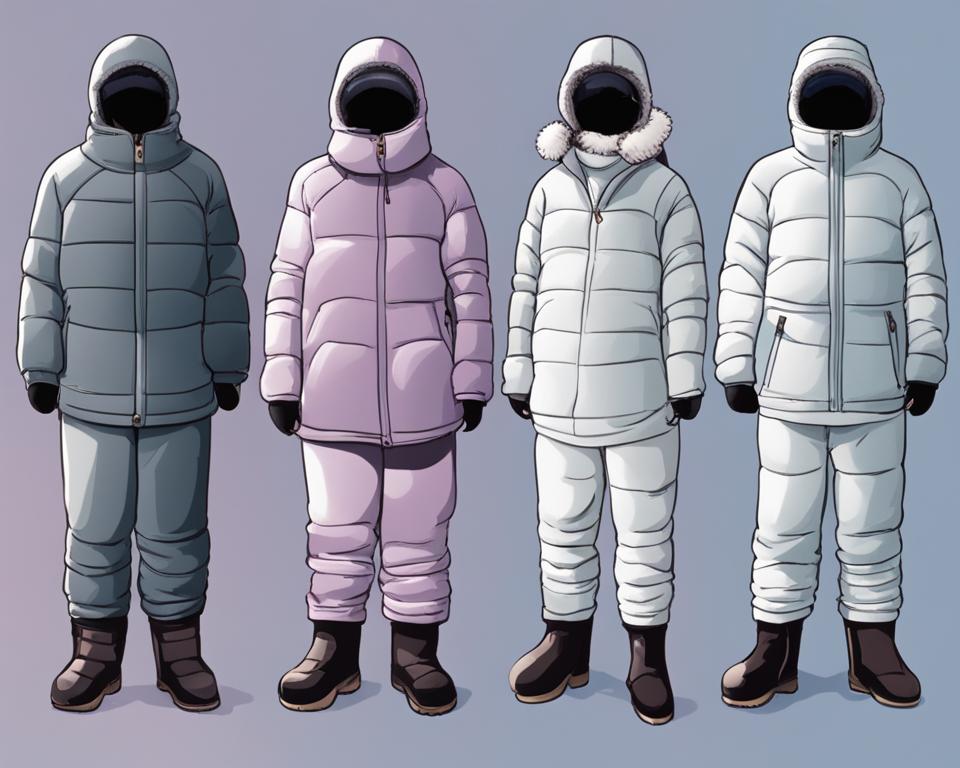Are you wondering if thermals can keep you warm in cold weather? Well, you’re in the right place! In this guide, we’ll explore the benefits of wearing thermals and how they work to keep you warm and cozy.
When it comes to staying warm in chilly temperatures, thermals play a crucial role. They are designed to provide insulation by preventing heat loss through conduction, convection, radiation, and evaporation. Unlike regular clothing, which may trap sweat and lead to rapid cooling, thermals absorb moisture from your skin and allow it to evaporate, keeping your skin dry and maintaining your body temperature.
Layering is another effective method for staying warm, and thermals are an excellent base layer choice. By layering with thermals, you create an extra barrier of warmth, trapping the heat close to your body. Whether you’re skiing, hiking, or simply braving the cold weather, thermals are your go-to clothing option.
Thermal clothing is specifically designed for cold weather conditions. It is made from moisture-wicking fabric that keeps you dry and comfortable by preventing sweat accumulation. The fabric typically features a honeycomb weave, which creates small air pockets that trap heat and prevent heat loss.
So, the next time you’re gearing up for cold weather adventures, don’t forget to include thermal wear in your outfit. With their insulation properties and ability to keep you warm, thermals are a must-have for anyone seeking comfort and protection in chilly temperatures.
Key Takeaways:
- Thermals are designed to prevent heat loss and keep you warm in cold weather.
- Base layers, like thermals, work by absorbing sweat and allowing it to evaporate, keeping your skin dry and preventing rapid cooling.
- Thermal clothing is made from moisture-wicking fabric with a honeycomb weave that traps heat and prevents heat loss.
- Layering thermals with other clothing enhances warmth and protection in cold weather conditions.
- Thermals are essential for outdoor activities and provide insulation and comfort in a range of temperatures.
What is Thermal Clothing?
Thermal clothing, also known as base layer clothing, is a type of clothing that is worn closest to the skin to keep warm in cold weather. It is made from a moisture-wicking and breathable fabric that helps to keep the body dry and comfortable. The fabric has a honeycomb weave that creates small pockets of air, which trap heat and prevent heat loss. Thermal clothing can be worn for various outdoor activities and everyday wear to provide insulation and comfort.
Thermal clothing is designed to prevent heat loss by trapping warm air close to the body. The moisture-wicking fabric absorbs sweat from the skin and allows it to evaporate, keeping the skin dry and preventing rapid cooling. This helps to regulate body temperature and keep you comfortable in cold conditions. The honeycomb weave in the fabric adds an extra layer of insulation by creating small air pockets that trap heat. This makes thermal clothing an ideal choice for staying warm in cold weather.
Thermal clothing is a must-have for anyone who spends time outdoors in cold weather. It provides a layer of insulation that helps to keep the body warm by preventing heat loss. The moisture-wicking fabric keeps the skin dry and comfortable, allowing you to stay active and enjoy your outdoor activities without feeling cold or uncomfortable.
Whether you’re skiing, hiking, or simply running errands on a chilly day, thermal clothing is a versatile and essential part of your wardrobe. It provides the foundation for layering, allowing you to add additional layers of clothing for extra warmth when needed. Thermal tops, bottoms, and accessories such as gloves, hats, and socks are all available to suit your individual needs and preferences. Stay warm, dry, and comfortable with thermal clothing!
Types of Thermal Clothing
When it comes to thermal clothing, there are various options available to keep you warm in cold weather. These options include thermal bottoms, thermal tops, and thermal accessories. Let’s take a closer look at each of these types of thermal clothing:
Thermal Bottoms
Thermal bottoms, also known as thermal leggings, are designed to provide insulation and warmth to your lower body. They are typically made from a combination of fabrics, including merino wool and bamboo fabric. These materials are known for their moisture-wicking properties, which help to keep you dry and comfortable while retaining heat.
Thermal Tops
Thermal tops, such as thermal tees, are worn as base layers to keep your upper body warm. Like thermal bottoms, they are made from moisture-wicking fabrics like merino wool and bamboo fabric. These fabrics are not only great at regulating temperature, but they also help to prevent sweat build-up, keeping you dry even during strenuous activities.
Thermal Accessories
Thermal accessories are additional garments that can enhance your overall warmth. These can include thermal gloves, hats, and socks. Thermal gloves provide insulation for your hands, while thermal hats and socks help to retain heat in these vulnerable areas. By wearing thermal accessories, you can further protect yourself from the cold weather.
| Type of Thermal Clothing | Main Materials | Key Features |
|---|---|---|
| Thermal Bottoms | Merino wool, bamboo fabric | Moisture-wicking, temperature-regulating |
| Thermal Tops | Merino wool, bamboo fabric | Moisture-wicking, temperature-regulating |
| Thermal Accessories | Various materials | Insulation, heat retention |
By choosing the right type of thermal clothing, you can ensure that you stay warm and comfortable in cold weather conditions. Whether you opt for thermal bottoms, thermal tops, or thermal accessories, the key is to look for materials that are moisture-wicking, temperature-regulating, and provide insulation. With the right combination of thermal clothing, you can enjoy outdoor activities without worrying about the cold.

Choosing the Right Base Layer
When it comes to base layer clothing, there are two main options to consider: synthetic fabrics and merino wool. Synthetic fabrics, such as polyester and nylon, are lightweight and quick-drying. They offer excellent moisture-wicking properties, which means they can draw sweat away from your body, keeping you dry and comfortable during physical activities. Synthetic base layers are also known for their durability and can withstand frequent washing without losing their shape or functionality.
On the other hand, merino wool base layers are naturally warm and have antibacterial properties. The soft fibers of merino wool are excellent at regulating body temperature, keeping you warm in cold weather and cool in hot weather. Merino wool base layers are also known for their comfort and are suitable for those with sensitive skin. While merino wool does take longer to dry compared to synthetic fabrics, it offers superior insulation properties and is naturally odor-resistant.
When choosing the right base layer, fit and comfort are crucial factors to consider. Synthetic fabrics tend to have a tighter fit, as they work best when in direct contact with your skin. This allows for optimal moisture-wicking and heat retention. On the other hand, merino wool base layers should have a more comfortable fit, allowing for better airflow and insulation.
Overall, the choice between synthetic fabrics and merino wool ultimately depends on your personal preferences and the specific activities you’ll be engaging in. Both options offer their own set of benefits, so it’s important to consider factors such as moisture-wicking, antibacterial properties, drying time, and overall comfort when choosing the right base layer for your needs.
| Base Layer Material | Benefits |
|---|---|
| Synthetic Fabrics | Lightweight, quick-drying, excellent moisture-wicking properties, durable |
| Merino Wool | Naturally warm, antibacterial properties, temperature-regulating, comfortable |
When and How to Wear Base Layers
Base layers are an essential component of a layering system that provides optimal warmth and protection in cold weather conditions. They are designed to prevent skin chill and wind chill by absorbing sweat and preventing rapid cooling. Base layers are versatile clothing that can be worn in a wide range of outdoor activities.
To determine when to wear base layers, consider the weather conditions and temperature range. Base layers are especially beneficial in colder temperatures, typically ranging from 15 to -20 degrees Celsius. They help regulate body temperature by insulating and trapping heat close to the skin.
When it comes to how to wear base layers, they can be worn on their own or layered with other clothing depending on the activity level and weather conditions. For high-energy activities, base layers can be worn as standalone pieces to provide maximum moisture-wicking and temperature regulation. However, in extreme cold or during low-intensity activities, layering base layers with additional clothing such as mid-layers and outerwear can provide added warmth and protection.
Whether you’re skiing, hiking, or simply enjoying a chilly day outdoors, base layers are a crucial part of your outfit. They offer flexibility, comfort, and the ability to adapt to changing weather conditions, making them an essential addition to your cold-weather wardrobe.

Benefits of Layering System
A layering system is a strategic approach to dressing for outdoor activities. It involves wearing multiple layers of clothing that work together to provide optimal comfort and performance. The layering system consists of three main layers: base layers, mid-layers, and outerwear.
The base layer is the closest layer to your skin and is responsible for moisture-wicking, insulation, and temperature regulation. It helps to keep you dry by wicking sweat away from your body, preventing the build-up of moisture that can lead to rapid cooling.
The mid-layer provides additional insulation and warmth. It traps heat generated by your body and acts as a buffer between the base layer and outerwear. It should be breathable and lightweight to ensure maximum comfort.
The outerwear layer serves as a shield against the elements, providing protection from wind, rain, and snow. It should be waterproof, windproof, and breathable to keep you dry and comfortable.
| Layer | Function | Example |
|---|---|---|
| Base Layer | Moisture-wicking, insulation, temperature regulation | Thermal top and bottom |
| Mid-Layer | Additional insulation, warmth | Fleece jacket |
| Outerwear | Protection from the elements | Waterproof shell jacket |
Conclusion
Thermals, also known as base layers, are a crucial component in keeping us warm during cold weather. They not only provide insulation but also prevent heat loss through various processes such as conduction, convection, radiation, and evaporation. By absorbing sweat from the skin and allowing it to evaporate, thermals keep the skin dry, minimizing rapid cooling.
Choosing the right base layer is key to reaping the benefits of wearing thermals. Synthetic fabrics like polyester are lightweight, quick-drying, and have excellent moisture-wicking properties, making them suitable for high-energy activities. On the other hand, merino wool base layers offer natural warmth and antibacterial properties, making them ideal for individuals with sensitive skin.
Layering base layers with other clothing enhances their effectiveness in providing warmth and protection. Depending on the weather conditions and activity level, base layers can be worn either on their own or layered with other garments. Their versatility allows for comfortable wear in a temperature range of 15 to -20 degrees Celsius.
Whether you’re braving the cold outdoors or simply seeking warmth in everyday activities, base layer clothing is a reliable choice. By understanding their role in keeping you warm, choosing the right base layers, and mastering the art of layering, you can ensure optimal comfort and protection in chilly conditions.
FAQ
Do thermals keep you warm?
Yes, thermals are designed to prevent heat loss and keep you warm in cold weather.
What are the benefits of wearing thermals?
Wearing thermals provides insulation, prevents rapid cooling, and keeps the skin dry and comfortable.
How do thermals keep you warm in cold weather?
Thermals work by absorbing sweat from the skin and allowing it to evaporate, preventing heat loss through conduction, convection, radiation, and evaporation.
What is the importance of thermals in staying warm?
Thermals act as a base layer that regulates body temperature, prevents heat loss, and provides insulation in cold weather.
Do base layers keep you warm?
Yes, base layers are designed to prevent you from getting cold by trapping heat and keeping the skin dry.
How can I layer thermals for maximum warmth?
Layering thermals with other clothing helps to achieve optimal warmth by creating a barrier against the cold weather.
What are the advantages of using thermal underwear for warmth?
Thermal underwear provides insulation, moisture-wicking properties, and comfort to keep you warm and dry in cold weather conditions.
What is thermal clothing?
Thermal clothing, also known as base layer clothing, is worn closest to the skin to provide insulation and keep you warm in cold weather. It is made from moisture-wicking and breathable fabrics.
What are the different types of thermal clothing available?
Thermal clothing includes thermal bottoms (leggings), thermal tops (tees), and thermal accessories (gloves, hats, socks). These garments are often made from a combination of merino wool and bamboo fabric.
What are the advantages of using synthetic fabrics for base layers?
Synthetic fabrics are lightweight, quick-drying, and provide excellent moisture-wicking properties, making them suitable for high-energy activities and sports.
Why is merino wool a good choice for base layers?
Merino wool has natural insulation properties, is warm, and has antibacterial properties, making it suitable for sensitive skin.
How should a base layer fit?
The fit of a base layer should be tight for synthetic fabrics to ensure maximum effectiveness. For merino wool, the fit should be comfortable.
When and how should base layers be worn?
Base layers should be worn in cold weather conditions and during outdoor activities to stay warm and comfortable. They can be worn on their own or layered with other clothing depending on the weather and activity level.
What is the temperature range for wearing base layers?
Base layers can be used in a temperature range of 15 to -20 degrees Celsius to provide warmth and insulation.


![Ray Dalio Quotes [Principles, Life, Investment]](https://tagvault.org/wp-content/uploads/2023/04/Screen-Shot-2023-04-19-at-7.57.49-PM.png)